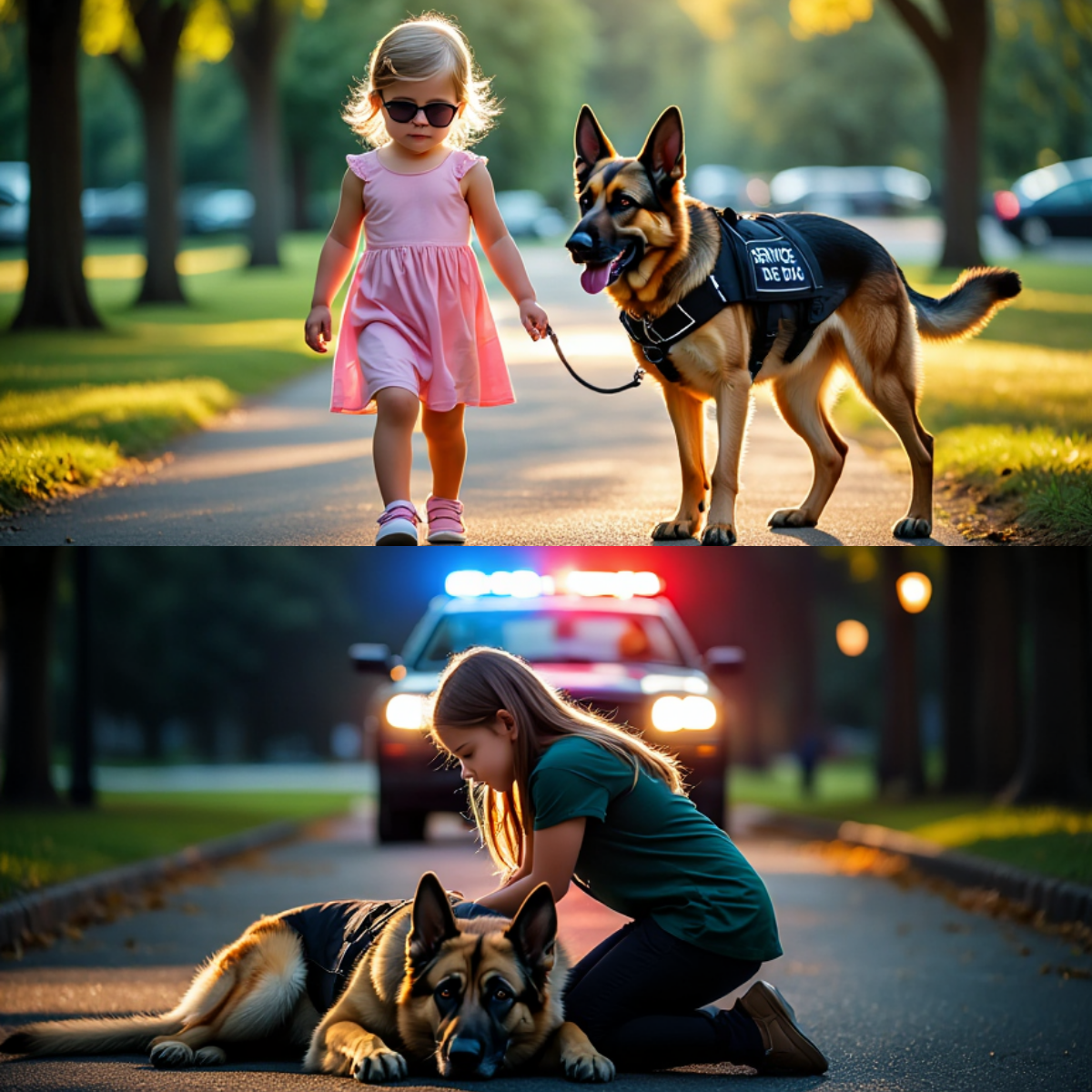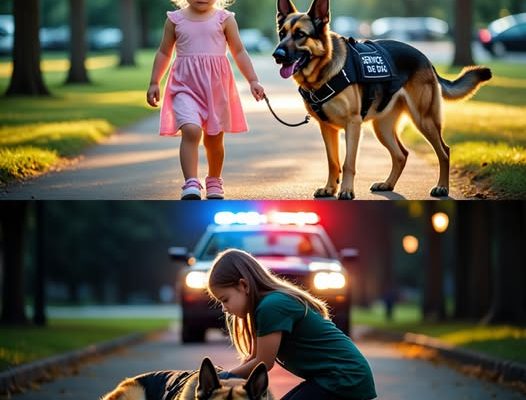A Morning That Should Have Been Ordinary
It was just past 8 a.m. in Chandler, Arizona — a sun-drenched morning like any other. Emily Grace Carter, a 9-year-old girl born completely blind due to Leber’s congenital amaurosis, was walking to her elementary school with Bruno, her certified K9 service dog. She had walked this same three-block route every day for months. The sidewalks knew her steps. Bruno knew every curb, every turn, every tree root.
That morning, Emily wore a blue backpack with a reflective patch that read “Blind Student,” and Bruno wore his official service vest — complete with medical identification and a bright yellow patch: “Do Not Pet — Working Dog.”
But just minutes into her walk, her world — already defined by sound and touch — was shattered by confusion, shouting, and sirens.
The 911 Call That Sparked the Chaos
A neighbor, new to the community, had dialed 911 to report “a child walking alone with a large, aggressive dog.” The dispatcher failed to note that the caller admitted they couldn’t see clearly and weren’t sure if the dog was a service animal.
Two officers were dispatched. What they found wasn’t a threat — it was Emily, slowly making her way along the sidewalk with Bruno gently leading her.

But what they thought they saw — without pausing to assess — was something entirely different.
One officer, later identified as a five-year veteran of the force, allegedly shouted at Emily to stop. But Emily, overwhelmed and disoriented by the sudden chaos, didn’t respond clearly. Bruno barked — not aggressively, but in alarm.
That single bark was all it took for the officers to act.
The Confrontation
Bodycam footage, now public after intense legal pressure, shows one officer approaching with his hand on his holster, while the other attempts to physically pull Bruno away from Emily. Bruno, doing what he was trained to do, inserted himself between Emily and the officer — head down, tail low, body protective.
What happened next has sparked global outrage.
Bruno was tackled, Emily was knocked to the ground, and for nearly 30 seconds, confusion reigned — until one of the officers shouted, “Oh my God — she’s blind!”
By then, it was too late.
Public Outcry and a Family’s Pain
The footage went viral within hours. Disability advocacy organizations, civil rights groups, and everyday Americans reacted with horror. #JusticeForEmily trended on social media. Protesters gathered outside the Chandler Police Department demanding answers.
Emily’s parents, devastated, held a press conference:
“Our daughter did nothing wrong. She was walking to school with the dog who gives her independence, safety, and confidence. And instead, she was treated like a threat. Bruno was treated like a criminal.”
Bruno suffered bruising, disorientation, and needed veterinary care. Emily, though physically unharmed, began having nightmares, refusing to leave the house without both parents by her side. “She lost trust,” her mother said. “In people. In the world.”
A National Reckoning on Disability and Policing
What started as a local incident exploded into a national reckoning. For the first time, service dog trainers, disability rights attorneys, and former police officials were called into televised roundtables to address a rarely discussed issue: the complete lack of standardized training for officers on how to interact with people with disabilities and service animals.

Shockingly, over 67% of U.S. police departments do not require any mandatory training on disability awareness. And fewer than 10% include modules on service dog recognition or protocol.
In response to public pressure, the Department of Justice launched a federal investigation into how local and state police forces handle encounters involving people with visible and invisible disabilities.
Several bills were fast-tracked in Congress, including the Service Animal Protection in Law Enforcement Act, which would make it a federal offense to attack or interfere with a certified service animal unless there is clear and imminent danger.
From Trauma to Transformation
Emily and Bruno’s story began as one of fear and injustice — but what followed was extraordinary.
After months of therapy and healing, Emily and Bruno returned to school together. Her classmates had created hand-drawn posters: “Welcome Home, Emily & Bruno.” Her teacher wept at the sight.
And something even bigger happened: Emily’s story ignited a nationwide educational campaign — “See the Dog, Hear the Child” — designed to train both officers and civilians in identifying and understanding service animals.
Emily became the face of that campaign.
Final Reflection: A Girl, a Dog, and a Nation’s Wake-Up Call
This wasn’t just about one girl or one city. It was about the way society often fails to see those who need us to slow down, to listen, to understand. In the rush to enforce, we forget to empathize. In the noise of sirens, we miss the soft voices asking for help.
Emily’s voice was soft. But it shook the system.
Bruno never said a word. But his bark echoed through the halls of power.
“He didn’t bite. He didn’t growl. He just stood in front of me,” Emily said. “Because that’s his job. He’s my eyes. He’s my best friend.”
And maybe… he’s the hero we all needed.






